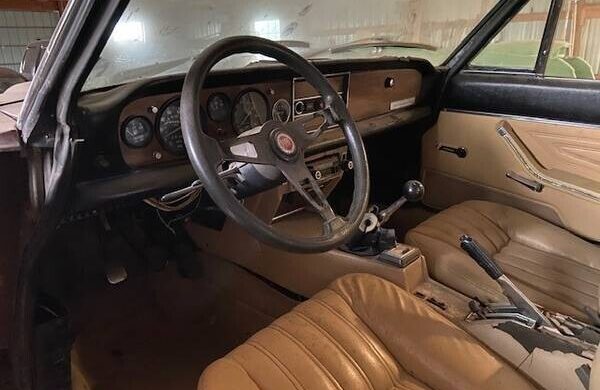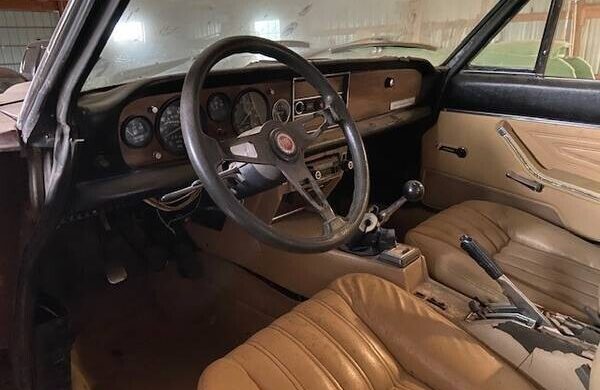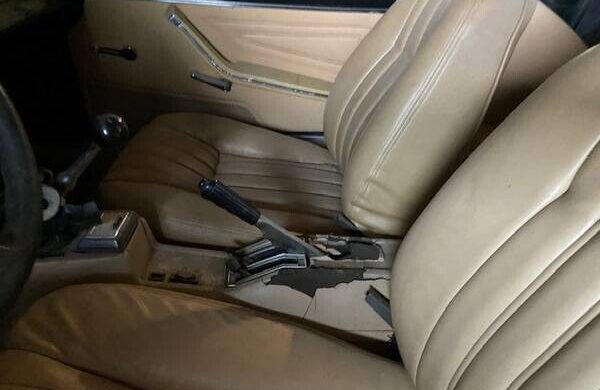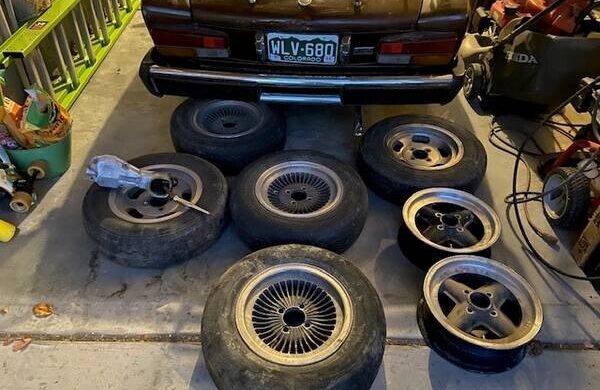Very Clean 1979 Fiat Spider At A Bargain Price
All Italian cars are determined rusters, especially those of the 1950s through the 1970s. It was always sunny in Italy, so why bother with rustproofing? Rusty Jones couldn’t get arrested over there. So if you’re going to undertake an Italian sports car project, it’s best to find an example that’s somehow escaped the tin worm. Just such a car is this 1979 Fiat Spider here on Craigslist in mile-high Brighton, Colorado, near Denver. Thanks to TJ for this find.
“The car is almost rust-free,” says the vendor who—in a familiar story—bought it as a project and, well, “haven’t had time to get started.” So it’s as found. Often that’s a sad story, but not so much here. The ad says 79,000 miles and a clean title. It all seems to be there, save a right-side rear marker light. Frankly, with a $1,500 asking price, this one won’t last long.
Under that dust may just be a solid and original brown paint job. The interior is far better than you’d expect. Virtually nothing needs attention, assuming the photos don’t lie. The seats look supple, the dash clean, the door panels in place. There’s a cool accessory trunk rack, probably not a common accessory. The glass appears OK.
Two pressing jobs: A new top (the current one is in shreds) and some appropriate wheels to replace the oversize mags that are on it now. But seven extra wheels come with the car!
There’s no word on the mechanical condition of the Fiat, but the owner “hasn’t spent the time to drain the gas and get it running.” The front end looks like it’s riding rather high, but maybe is it propped up on those tires there. An engine does appear to be present, and a transmission too if the shifter is connected to something.
The beautiful Fiat 124 Sport Spider—a timeless Italian design—debuted in 1966 and had a long life, until 1982. And that wasn’t the end, either, because Pininfarina couldn’t let go—it badged the car as the Pininfarina Spider Azzurra and sold it on the American market until 1985. Pininfarina didn’t sell it’s own car again until now—and it’s a $2 million supercar EV (with platform borrowed from Rimac).
For a long time, the 124 Spider was the poor man’s Alfa Spider, but now they’re coming into their own. The good looks have come to the fore. Both the Alfa and Fiat have twin-cam engines. The Fiat started out with a 1.43-liter four with a crossflow head, designed by the famed ex-Ferrari Aurelio Lampredi.
For 1979, near the end of Fiat production, the four had grown to 1,995 cc, and produced a lusty 104 horsepower. But the Weber carbs were still in place—Bosch fuel injection didn’t arrive until the middle of 1980. With the larger engine, the cars were known as Fiat 2000 Spiders. Other modern touches on the Spider were four-wheel disc brakes, a five-speed manual transmission (though an automatic became available in 1979) and radial tires.
It’s hard to see how a buyer could go wrong with this car. Am I missing something?
Auctions Ending Soon
 1969 Ford MustangBid Now15 hours$1,050
1969 Ford MustangBid Now15 hours$1,050
 1965 Ford Falcon Station WagonBid Now3 days$2,300
1965 Ford Falcon Station WagonBid Now3 days$2,300
 2002 Jaguar XK8 ConvertibleBid Now4 days$4,250
2002 Jaguar XK8 ConvertibleBid Now4 days$4,250
 1979 Chevrolet Camaro Z/28Bid Now5 days$4,500
1979 Chevrolet Camaro Z/28Bid Now5 days$4,500
 1960 Dodge D300Bid Now5 days$300
1960 Dodge D300Bid Now5 days$300










Comments
TJ,
I want to know your secret on how you get all of your submissions
featured here.I’v tried (& tried,& tried…etc.),never getting any accepted,&
I tried to only submit really interesting & unusual finds.I only do this because
I want to share them here.
I often wonder if I ticked off the staff here,& wasn’t aware of what I did.
Hi angliagt, please don’t stop sending us your submissions. We appreciate the input from our readers and always will. There can be many reasons why leads don’t make it through, with the most common being the listing ending before we get to them. I undertake to keep an eye out for your leads and write some for you. Don’t give up, and thank you for your input. Regards, Adam.
Click on fast finds for your answer, the people getting cars featured, submit them in bunches!
Agreed. Flood the tip line every single day and you are bound to get a few cars featured.
Individual daily submissions should be limited to a number around 5… then others here will get their cars highlighted more often. My 2 cents.
Adam,
Thank you for taking the time to respond,& explain.
It’s been said that Fiat perfected rust, then licensed it to Volkswagen.
Let’s not forget the engines in these fine automobiles. We used to refer to them as time bombs. And, at 80k? The previous owner(s) had better have kept up on the maintenance.
Hi Big C — are you talking about Fiat engines in general, or the engine in the Fiat Spider? This is one of my favorite engines! Why did “we used to refer to them as time bombs”? Because it’s an interference engine and people didn’t bother to change the timing belts on schedule? I think it was the first production engine with timing belts, so maybe people didn’t understand the required maintenance, but there are many engines with this “feature” now. This engine is a Lampredi Twin Cam, which was used by Fiat from 1965 all the way until 2000, with displacements from 1300 to 2000, normally aspirated and turbocharged, in everything from this car to the Lancia Delta Integrale, putting out up to 200 HP. If it were a “time bomb”, you’d think maybe they would have come up with a better engine somewhere along its 35 year run. Morgan even chose it as the engine to go into its Plus 4 during the ’80s. For many years, it was a popular “shade tree” transplant in little cars like Midgets and Morris Minors. My 1438 blasts along at 7000 RPM and sounds great. My prior Spider made it to nearly 200k miles before it got put out to pasture for its rust, but its “time bomb” was still humming along.
Shane is 100% correct. Big C is grossly misinformed. Other than regular maintenance, the timing belt was key. They were easy to change and if that was changed at recommended intervals, they were quite dependable . Those motors were well designed by Lampredi, a very well respected engineer.
The 1962 Glas 1004 was the first mass-produced vehicle to use a timing belt.
https://en.wikipedia.org/wiki/Glas_1004
I worked for a Fiat dealer in the 60’s and 70’s. The motors were as good as any except the 1100 which broke the crank regularly. The twin cam was solid and the only major issue was people not changing the timing belt. There was another customer induced problem we saw regularly. The air cleaner had 4 little bushings over the studs, and if you were not careful, when lifting off the cleaner, one of the bushings could drop down the carb. It would make its way into the cylinder and usually get spit out the exhaust, but sometimes it would get stuck on top of the piston and you would get a ticking sound. The solution was to run the car down the road at 6K rpm and hope it would get dislodged and go out the exhaust. This worked in about half the cases. If not, pull the head.
The only issue with these engines is the timing belt. It must be replaced every 60K and I’d do it at 50K. It’s an interference engine. Otherwise, they’re rock solid high-revving engines. The electrics can be a bit of a nuisance. The earlier 70s models were carbureted (Webers? Dellortos?) but by I believe 1975 they used a Bosch injection system.
I still have a full box of valve shims and the special tools to do the shim replacement for both the 124s and 128s from when I was wrenching on them 30+ years ago.
Like the earlier Japanese cars, these Fiats had a tendency to dissolve from rust even in the south (where a buddy of mine had a very well-maintained 73 suffering from the cancer).
Fiat introduced Fuel Injection mid-way through the 1980 model year. Prior to then, they had always used Weber carbs
It wasn’t an engine problem. It was an inadequate maintenance problem. Until the introduction of the 2.0 L, the Lampredi engine was an interference design. Failure to replace the Gilmer belt at regular intervals (17,500 miles per factory manual) could result in valve/piston contact and an expensive repair bill. The 2.0L was a non-interference engine.
The Lampredi designed Fiat/Lancia DOHC was the most successful engine in the history of World Rally Championships winning ten such Championships. The 2.0L version ranged in power from 80HP to 215 HP depending on the application. I would have liked to have the latter in my ’77 Lancia Beta (I desmogged the 1756cc Beta engine and fitted an upgraded Weber carb which noticeably improved performance and still passed State emissions inspection). The engines easily rev to their 6,250rpm redline and beyond with no rough spots.
FWIW, a 2.1L competition version produced 325 HP.
Agree with you and Eric. I had a 1982 Pininfarina 2000 and owned it for 30 years. 120,000 miles when I sold it to a collector in Australia. Never had an engine problem. Replaced the timing belt 4 times but that’s cuz I liked to keep the RPMs up there where they belong! The only electrical issues I had was with the radiator fan switch, so I bypassed it to a toggle switch I put down near your left foot. Switch on / switch off. And I blew out the rear end at ~75,000 miles. Turns out it was made in Spain in 1982 (junk) and had a new one shipped from Milan. Otherwise, normal routine maintenance and a ton of fun on the street and track.
I love hearing the stories about how rock solid FIATS, were. Thanks for the memories.
Please supply the photos of the “very clean” Fiat Spyder.
Even these Fiats have Italian style. Front, looks a little like a Lusso!
Until 1984 just all cars rusted except a few. The Pininfarina
named cars have had the better build quality then the FIAT
made.
On this car Gotti rims fit very well or Abarth or VX, or at least
the original Cromodora with the large chrome center cap.
And its missing the right side mirror. Center console cracked.
How it its mechanical condition and rust? Because some
machanical parts like the airflow meter are expensive.
Having owned numerous 124’s, 2000 and 2 Pininfarinas I’ve never had any trouble blowing them up. The key to keeping these babies going was maintenance. They were all a blast to drive and upgrading to an ANSA exhaust system gave them the sound. At 76 I’m down to my last Fiat and they have all been fantastic.
I’m with ya! Bought my 1982 Spider 2000 in 1985 and keep her for 30 years. Restored her, enjoyed daily drives. Sold her to Italian car collector in Australia. Loved every year with “Farina”. Did my own maintenance so maybe that helped extend her life?
This has to be worth the price – $1,500 doesn’t buy much anymore.
Just in parts alone, but this one looks like it could be ressurected with a bit of effort.
They didn’t all rust. Fiat 125S bought new in New Guinea in 1970.
Shipped to the UK, driven through Europe to Greece and back to the UK. Shipped to Australia in 1971.
Finally sold out of the family in 1981. ONE rust spot in a front mudguard in that time
The suspension looks to be riding a bit high in front. There also appears to be a large gap directly under the front end just ahead of the wheels where I would normally expect to see – er, uh, something.
The appearance leads me to wonder if there is actually a motor in this little car. There aren’t any pictures of it.
Oh, and the passenger side rear marker light is also missing as is the rear bow on the top.
Still, the price seems like a very good enticement. These were a hoot to drive.